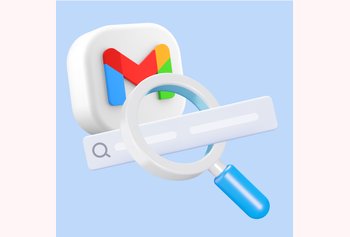57%. That’s the number of people who prefer email over other digital customer service channels, making it the most preferred customer service channel. Despite its age, email still outranks its peers like social media and live chat.
This means one thing for sure: you can’t afford to ignore email as a customer service channel. How do you make sure your company uses email to its maximum potential and offers excellent customer service?
The answer lies in adopting customer email management software. These can help you organize your customer emails and solve issues like:
- Handling a large volume of emails:Customer service teams often encounter a large volume of emails from customers. Having the ability to organize and streamline these emails can help these teams function effectively and efficiently.
- Offering lower turnaround time: According to Microsoft’s research, 54% of customers have higher expectations for customer service today than one year ago. This percentage jumps to 66% for consumers aged from 18 to 34 years old. This effectively means that speed is key. Customer email management software can help you save time, respond to queries faster, and keep your customers happy for longer.
- Staying on top of your team’s activities: A customer email management software will help you get an accurate view of how your team is performing, i.e., how many customer emails the team receives, how quickly emails are being assigned, the load on individual customer service representatives, response and resolutions times and so on. This data can feed into your customer lifecycle management and help you serve your customers better.
The best customer email management software can make your customer service team’s life easier.

Table of Contents
- Top features to look for in a customer email management solution
- Email Assignment for better accountability
- Email Notes for internal collaboration
- Email Tags for better inbox management
- Email Templates and Shared Drafts for faster, consistent replies
- Workflow Automations for lightning-fast customer service
- SLAs for providing top-notch customer service
- Real-time Collision Alerts for preventing those ‘Oopsie-Daisies.’
- Reporting capabilities for upping your customer service game
- Customer Satisfaction Surveys (CSAT) for getting a pulse on your customers
- Personalize & track customer conversations with Hiver Contacts & Conversation ID
- A Knowledge Base to help your customers self-serve
- Manage tasks inside Gmail with Hiver Integrations
- Hiver’s AI Bot – Harvey
- Wrapping up: choosing a customer email management software in 2024
Top features to look for in a customer email management solution
If you’re evaluating email management software for your team, here are the top 10 features that you can’t afford to miss out on.
Email Assignment for better accountability
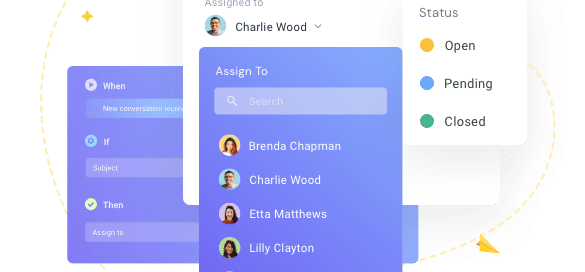
Email Assignment, otherwise known as Email Delegation, ensures that every incoming customer email gets a dedicated owner. With software like Hiver, you can delegate incoming emails to your team members with a single click right from Gmail. Once an email is assigned to a member of your team, they will receive an instant notification letting them know about the email that has been assigned to them. With no email forwarding/CCing involved, it keeps emails threads clean and prevents emails from falling through the cracks.
Take the case of Countless, a New York-based full-service accounting firm. Their team used a single Gmail inbox to manage all client interactions. As they expanded, they understood the need for a solution to help them efficiently collaborate over email, delegate tasks, and share responsibilities.
Their search led them to Hiver. With Hiver, they assign emails to teammates without having to forward them. Every email gets a clear owner and a status (Open, Pending, or Closed). The team is always on the same page about who has to work on what. Hiver has been highly instrumental in helping their team have contextual conversations about specific client emails – right within Gmail.
Email Notes for internal collaboration
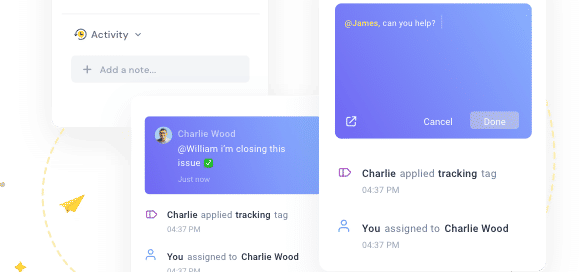
Email Notes gives your team instant chat-style collaboration right inside Gmail. Instead of forwarded emails, CCs, or external collaboration tools, Email Notes allows your team to go into a private huddle right beside the email thread. This greatly reduces the back and forth needed to build context, saving a considerable amount of time and effort.
What’s more, you ask? Well, when team members can discuss a customer issue internally, you’ll never have to worry about a forward or a reply accidentally reaching the customer.
Bergen Logistics, a global logistics company, focused on the fashion and lifestyle sector, was using Google Groups to manage their internal team communication among account managers. Because of the inherent nature of Google Groups, the team quickly ran into issues that made it challenging to manage customer accounts, as well as internal team processes. One of their most significant pain points was that senior account managers could not proactively step to assist their teammates with solving customer issues.
To bring more clarity in the way their team works, Bergen Logistics decided to try out Hiver. Fast forward to now, and one of the biggest advantages that Bergen Logistics has seen with Hiver is the tool’s collaboration capabilities. With Email Notes, senior team members were able to step in and help newer teammates solve customer issues faster; they could reduce delays in responses that occurred when customers reached out to their account managers, who happened to be on breaks or out-of-office.
With Email Notes, they have drastically reduced the number of escalations needed to solve customer issues, leading to increased customer satisfaction levels.
Email Tags for better inbox management
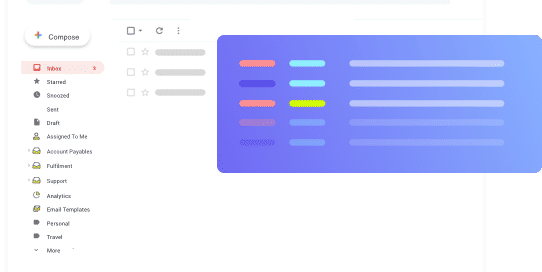
Email Tags can help you categorize and prioritize your customer emails better, taking your inbox from chaos to the much-needed sense of clarity. In a customer service scenario, you would routinely need to categorize emails based on type or priority. This way, your team can quickly find relevant conversations, respond to them, and deliver a better and more personalized customer experience. Tags in Hiver are easy to use. Simply select one or more Tags from the dropdown menu in the Hiver panel and add them to your email. You can even run automations to add Tags to incoming emails based on rules. Tags can be customized for easy visibility. If you and your team are always on the lookout for the elusive ‘inbox zero,’ there’s no better tool than Email Tags to get you there.
Take the example of Flexport — a freight forwarding and customs brokerage company based in San Francisco, California. They are on a mission to foster free trade across the world through technology. Their full-service logistics platform uses state-of-the-art software to fix the user experience in global trade.
The operation team handles inquiries from shipping companies that use Flexport. The team receives around 1000 customer emails a month, which are then assigned to team members based on the ocean shipping line involved. The team was using Gmail’s filters to manage their workflow. They were also using Slack to assign emails to each other based on subject lines. This made it difficult to establish ownership, leading to frequent misses, and delayed customer responses.
The operations manager, Nathan Strang, started looking for a better way to manage customer emails and was introduced to Hiver by their Accounts Receivables team. With Hiver, the team from Flexport put an end to forwarding for good. When Nathan has to assign an email to someone on his team, he just attaches a Tag with the teammate’s name to it. It’s easier for him to give every email an owner. They have stopped missing emails altogether.
The net result: They improved their response times by a whopping 50%.
Email Templates and Shared Drafts for faster, consistent replies
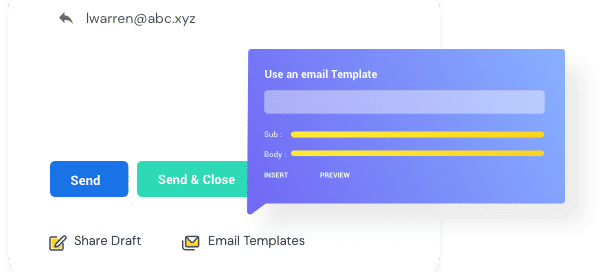
Most customer service teams receive repetitive queries. And there’s no reason for your team to type out the same replies over and over again. Email Templates (sometimes known as Canned Responses) serve as a reservoir of sorts that contains responses to the most commonly asked questions by customers. Your customer service team can quickly personalize/modify these templates and send them to customers, resolving their issues in a matter of minutes.
With Hiver, this is even more simple. How simple, you ask? As simple as using just one click to add a template right inside the Gmail compose window.
PS: If that sounds interesting, you should check out these customer service email templates.
And if your cookie-cutter emails aren’t cutting it anymore and you need additional help from your teammates to write that perfect email, then make sure your customer email management software comes with Shared Drafts. Shared Drafts turn your email drafts into real time collaborative workspaces just like Google Docs.
Specialty Box, a New York-based customized packaging solution provider, was on the lookout for a solution that would help their customer service team adopt AGILE processes(agile transformation was a big focus of the company).
Joshua Fialkoff, their COO, who has a software app development background, was very specific in his requirements for a tool to manage Specialty Box’s customer service. After trying out multiple tools, including Zendesk and Front, he chose Hiver. Joshua and the team love Hiver’s Email Templates. The templates serve as canned responses, which can be organized into folders and shared with the team.

Hiver’s Email Templates have helped them significantly decrease response time, made customer communication more consistent, and, most importantly, helped them in their larger goal of reducing email noise.
Workflow Automations for lightning-fast customer service
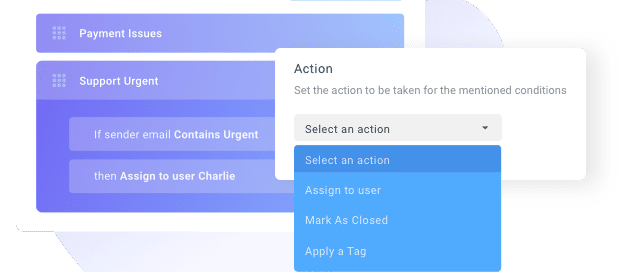
Speed. In customer service, speed is key. According to Forrester’s Research, 66% of consumers believe that the most important thing a company can do is value their time during a customer service interaction. One foolproof way to achieve speed is by using automations.
Therefore, investing in customer email management software with workflow automation capabilities might be a smart choice.
While you can manually assign emails to your team members, or manually add tags to emails based on the subject line/sender, wouldn’t it be a lot more efficient to automate these simple actions? Not only would this help your team respond faster and better, but it could also help free up time, which can be invested in training the team further or involving them in work activities to help improve mental health, for instance.
Myles Schepetin leads and manages a team of sales professionals at New York Custom Labels, an American manufacturer of custom labels and patches. A major share of the team’s day would be spent managing emails arriving at the sales@ email address. With the growing business, managing these emails was becoming increasingly harder by the day. Assigning emails to team members was anything but straightforward: once a customer email arrived — Myles manually navigated through the messages — and forwarded the email to a team member’s inbox. This was incredibly inefficient. But this was five years ago.
Cut to the present day, where Myles and his team have been using Hiver, managing sales inquiries and conversations with existing customers painlessly. The sales team at New York Custom Labels uses Auto Assignment to assign emails to team members with zero manual work. Myles no longer spends time forwarding emails to his team members. And this has had a significant impact on how fast they send quotes to customers — which is also key to closing more deals.
SLAs for providing top-notch customer service
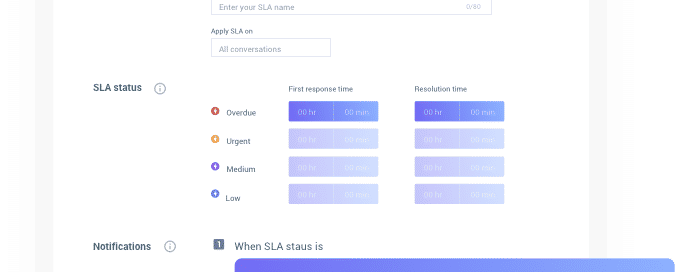
When you purchase a product from a company, you expect a certain level of customer service. For example, an SLA may indicate that 90% of support requests received by a company will be responded to within 6 hours.
A Service Level Agreement or SLA is a formal agreement that a business provides its customers with guaranteeing certain minimum levels of service. An SLA can help a customer service team determine how quickly a support request must be responded to, giving them a quantifiable goal to achieve. Companies also use SLAs to organize and prioritize support requests and better understand their customers.
Creating SLAs also helps teams become more accountable. Often, failing to meet SLAs can result in cash payment or a discount to the customer. This compensation is for the business inconvenience that may occur from the poor support experience.
Customer email management software like Hiver come with SLAs and Business Hours as built-in features. You can easily set up your business hours and then create SLA policies depending on the customer type or severity of the issues. Whenever an SLA is violated, Hiver automatically sends a notification to the team, letting them know of the breach. This way, someone from the team can step in and nip the problem in the bud before it snowballs.
Take the case of AppsFlyer, a SaaS mobile marketing analytics and attribution platform headquartered in San Francisco, California. They work with more than 12,000 customers, including leading brands like Walmart, Nike, HBO, Tencent, and NBC Universal.
Michelle Reznick is the Billing and Collections Team Leader at AppsFlyer. Her team is responsible for managing all finance-related issues of thousands of customers. Their accounting@ inbox receives more than 100 finance-related emails every day.
Systematically managing them and resolving customer issues promptly is the key to keeping customers happy. But, they were finding it tough to stay on top of emails. There was no system in place to assign emails to team members. Michelle would manually navigate through emails to see who had to work on which one — and then forwarded the message to them. Once she forwarded an email to someone, she had no visibility into its status. There was no way for her to ensure that the team was meeting their SLAs. Worst of all, the team sometimes missed working on a few emails. This was when she decided to start looking for a solution to manage the accounting@ inbox better.
They first tried out Zendesk, but they found it overwhelming and complicated. The search for a more straightforward solution led them to Hiver. With Hiver, Michelle was able to set up SLAs for the team, allowing her to monitor and improve her team’s email performance, thereby helping AppsFlyer in forging stronger customer relationships.
Real-time Collision Alerts for preventing those ‘Oopsie-Daisies.’
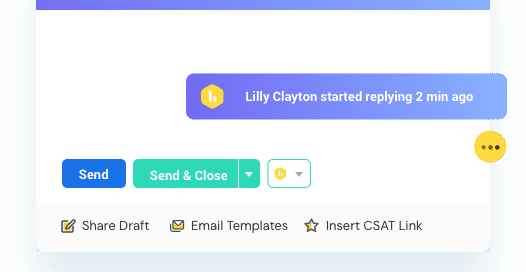
One of the biggest challenges of using a group email address with a common login or systems like collaborative inboxes and Google Groups is that there is no way to detect if a customer email has already been replied to. This often leads to embarrassing situations where a customer might receive multiple (and sometimes even conflicting) email replies. Can you even imagine how frustrating this would be for a customer?
A customer email management software with real time collision detection can come in handy here. For example, Hiver’s Collision Alerts provide users with large, easy to see visual cues that indicate email collisions.
How does it work? Simple. When a user starts replying to an email that you are working on, Hiver shows you a floating notification with the name of the other user who is currently working on the email draft in real time. This notification can prevent users from jumping the gun and reduce the instances of duplicate email replies.
Oxford Business Group is a research firm (established in 1994) specializing in gathering business intelligence on emerging markets worldwide. Christian Sibayan manages one of the key teams at Oxford Business Group: Field Operations. His team is responsible for assisting the agents in the field.
The team receives large numbers of queries and requests from field teams — and they must assist the agents in as little time as possible.
Christian’s team was initially using Outlook to manage the (usually heavy) influx of emails. But, there was one major problem: the team leads had no intuitive way to find out who was working on which support email. This made it difficult for the team leads to ensure that the field agents got their requests attended to on time.
Their search first led them to Kayako, a ticketing platform. This was also problematic. Replying to emails was anything but straightforward: While the platform allowed the team to view and read emails, they had to go outside of Kayako to respond to some of them. With the continual back and forth between tools, assisting those on the field became tiresome and confusing.
Their search for a simple, Gmail-based solution led them to Hiver. Because Hiver works within Gmail, onboarding was a breeze, and they were up and running in no time. Hiver transformed internal collaboration at Oxford Business Group. With collision alerts, team leads were instantly able to see when another user was working on an email, letting them know that they should step back.
This simple change has helped the team become 50% more efficient and reduce the average first response time by over 60%.
Reporting capabilities for upping your customer service game
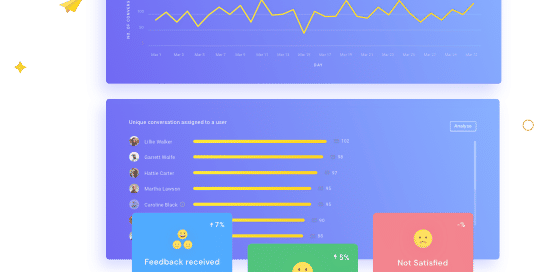
Gmail or Outlook, for that matter, doesn’t have any native reporting features. Trying to compile customer service metrics from your email would involve complicated workarounds and countless spreadsheets, and the effort needed would perhaps outweigh the results.
Fortunately, some customer email management software provide native reporting capabilities to help you stay on top of your customer service team’s performance. Hiver, for instance, comes with a plethora of visual reports which give you deep insight into your team’s customer service email metrics. Here are some of the reports that you can get with Hiver:
- Conversation Reports: You can use these reports to analyze how many conversations have taken place, how quickly your team responds to emails, and the average time taken by your team to resolve an issue.
- User Reports: User Reports help track every aspect of individual team member performance, including their overall workload, response and resolution times, and Customer Satisfaction (CSAT) ratings.
- Tag Reports: Tag Reports in Hiver help you keep track of email conversations by their tag names. These reports can help you identify trends in conversations, find roadblocks, and better allocate resources to mitigate them.
- CSAT Reports: With Hiver’s CSAT (Customer Satisfaction) Reports, see all of your CSAT feedback in your customers’ own words — in real-time.
And if these don’t meet your business needs, you can even use Hiver’s Custom Reports to build your own unique reports from scratch.
Let’s take the example of Vacasa, an international vacation rental management company based in Portland, Oregon. The team at Vacasa uses email extensively for communicating with its customers. For them, efficiently managing email requests is a crucial step in fulfilling the promise of superior customer support.
But things weren’t quite straightforward. The support team was using Google Groups to manage support emails. That brought along a host of problems. One of the more glaring ones was that there was no way to know how an agent was doing, as Google Groups did not offer reporting and analytics. How quickly did agents reply to an email? What was the average closing time? The team at Vacasa couldn’t find out these things.
The support team did not want to move to a conventional helpdesk as that would require training the agents. That’s when the Vacasa support team started looking for a customer support solution that worked inside Gmail and found Hiver.
Vacasa loved the fact that Hiver offered extensive reporting and analytics, helping them understand every agent’s performance. Hiver’s analytics feature provides actionable information like ‘Average Time to First Response’, and ‘Average Time for Resolution’ for every agent, among other critical data.
This has helped Vacasa proactively identify agents who need help, and train them better. By doing this, Vacasa’s support team has become 80% more productive and every agent now closes 60% more queries on a daily basis.
Customer Satisfaction Surveys (CSAT) for getting a pulse on your customers
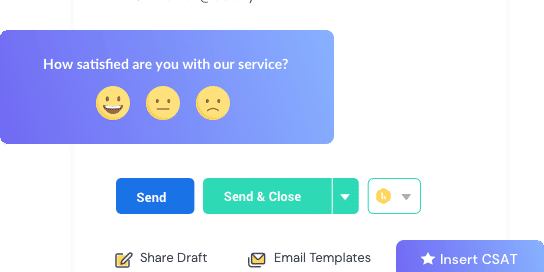
Customer Satisfaction (CSAT) is a basic measurement of a customer’s satisfaction with a brand’s product or services. CSAT surveys give happy customers a chance to share the reason for their happiness and unhappy customers a convenient channel to voice their issues.
CSAT surveys typically measure customer satisfaction concerning a specific experience. A typical CSAT survey would have a question like, “How would you rate your overall satisfaction with the service you received?” The customer would be expected to respond to the CSAT survey on a scale of 1 to 5, where one represents ‘very unsatisfied,’ and five represents ‘very satisfied.’
CSAT surveys are typically used by marketers and customer service teams to get customer insights and feedback on any one of the following areas:
- Customer service interactions
- Sales interactions
- Customer onboarding
- Event feedback
- Customer health
- Product/Service feedback
- Website interactions
Hiver makes it easy to create and embed CSAT surveys in emails. Survey questions can be customized to suit your business needs, and the survey can be embedded in the body of the email with a single click. You can also use the CSAT Reports in Hiver to view and analyze customer feedback.
Personalize & track customer conversations with Hiver Contacts & Conversation ID
Hiver Contacts provides you with a view of the most recent conversations that customers have had with your teams. Along with relevant context (CSAT rating, resolution status and more),this helps you craft more personalized responses.
Hiver Contacts Directory helps you view all your customers’ information (name, email address, and company) in one place. You don’t have to worry about losing track of customers, nor spend time manually collecting and organizing their information in your records.
With Conversation ID, locate the desired conversation effortlessly without wasting time searching through the inbox. Having a unique Conversation ID for every email conversation will allow you to identify any conversation with ease. If needed, share it with your end-users as a reliable point of reference for tracking or following up.
A Knowledge Base to help your customers self-serve
A Knowledge Base acts like a central repository of information, and is easily accessible through smart search results.
Hiver’s Knowledge Base feature allows you to create and maintain a repository of FAQs, troubleshooting guides, and other help articles, that can be easily accessed by existing and potential customers. It empowers customers to resolve issues whenever they want, without waiting for help. At the same time, it boosts the support teams’ productivity by helping them deflect common customer queries.
Manage tasks inside Gmail with Hiver Integrations
Hiver Integrations (with apps like Jira, Salesforce, Asana, QuickBooks, Okta & more) let you manage all internal communication and collaboration efficiently, right inside Gmail.
Get complete context and visibility into projects and tasks with apps like Asana and Jira. Use the Salesforce CRM data to automatically assign customer conversations to the right support reps.
And, the best part: it just takes a few clicks to enable any integration!
Hiver’s AI Bot – Harvey
Harvey has been designed to offer intelligent suggestions and perform the grunt work, boosting team productivity. Intelligently detect non-actionable responses on conversations and resolve them, saving time for support agents.
These 13 features come together to empower your team and to help them deliver the best customer experience.
Wrapping up: choosing a customer email management software in 2024
By now, you know that you are looking for a customer email management software to help your customer service team put their best foot forward. But with the plethora of solutions available in the market, choosing the right one for your business can be challenging.
And that’s why we’ve put together this guide to help you find the perfect customer service software in 2024.













